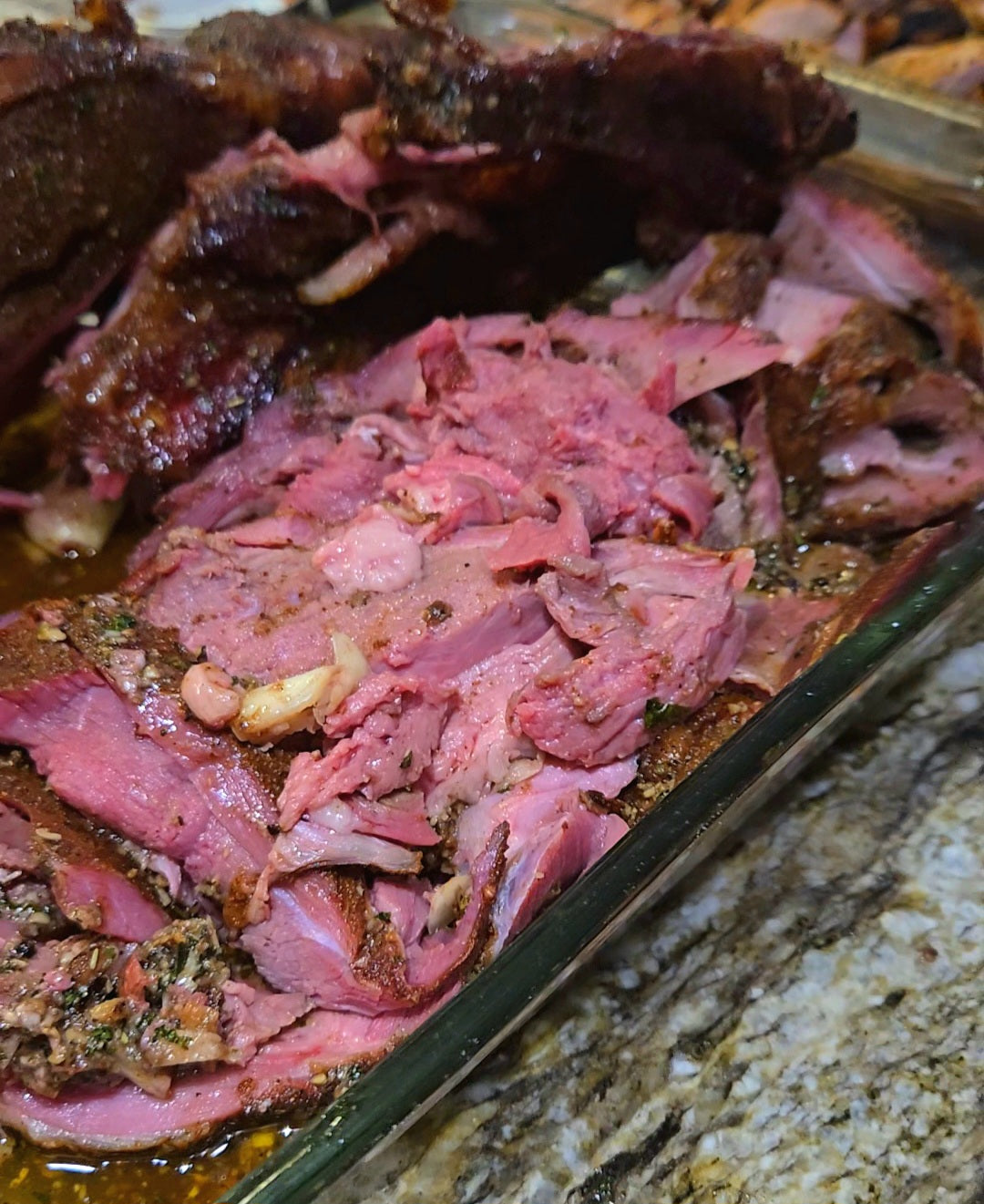
Rotisserie Leg of Lamb with Blaxican Fajita Seasoning
Achunchigan LattoreShare
Rotisserie Leg of Lamb with Blaxican Fajita Seasoning
The Blaxican Fajita Seasoning, described as a "perfect balance of savory and mildly spiced," complements the lamb beautifully, giving it a smoky, Tex-Mex-inspired crust.

Ingredients
1 whole leg of lamb (bone-in or de-boned, your preference)
8–10 whole cloves of garlic
Kosher salt (a generous, liberal amount)
Blaxican Fajita Seasoning (a generous, liberal amount)

Equipment
Sharp knife for trimming
Rotisserie spit and forks for your grill (Weber Searwood XL recommended)
Butcher's twine (optional, for trussing a de-boned leg)
Instant-read meat thermometer
Airtight container or tray for resting in the refrigerator
Oven or cooler for the resting period

Instructions
Phase 1: Prep and Dry Brine (Day Ahead or at Least a Few Hours)
How to prep?⬇️⬇️⬇️
<iframe width="560" height="315" src="https://www.youtube.com/embed/6i4ONPeKJio?si=iTfvIp7yLzIivapR" title="YouTube video player" frameborder="0" allow="accelerometer; autoplay; clipboard-write; encrypted-media; gyroscope; picture-in-picture; web-share" referrerpolicy="strict-origin-when-cross-origin" allowfullscreen></iframe>
Trim the Lamb: Use a sharp knife to carefully trim the silver skin (a thin, tough membrane) from the exterior of the leg of lamb. This will help the salt and seasonings penetrate the meat and allow the exterior to crisp up nicely.
Garlic Pockets: Smash the whole garlic cloves gently to partially break them, which releases their oils and aroma. Use a sharp, thin knife to poke small, deep holes all over the leg of lamb. Stuff one smashed garlic clove into each hole.
Dry Brine with Salt: Liberally coat the entire exterior of the leg of lamb with kosher salt. "Liberal" means coating all surfaces as if you were salting a thick steak for the grill. The salt will draw out moisture, dissolve, and then be reabsorbed, seasoning the meat deep inside and helping to tenderize it.
Refrigerate: Place the salted lamb on a rack in a tray ( or your DripEz Prep Tub) (uncovered is best for maximum drying) and rest it in the refrigerator for at least a few hours, or preferably overnight (up to 24 hours). This dry brining process will create a drier surface, which is key to developing a crisp crust (the "bark") during the cook.

Phase 2: Seasoning and Rotisserie Setup
Bring to Room Temperature: 60–90 minutes before your cook time, remove the seasoned leg of lamb from the refrigerator and let it sit at room temperature.
The Reason: This process slightly raises the temperature of the outer layers of the meat, ensuring that the entire leg cooks more evenly from edge to center. If you put a cold roast directly on the grill, the outside would overcook before the center reaches the target temperature. This is key if you are wanting a rare or medium rare finish on your roast. If you are shredding the meat at the end, disregard that.

Mount on the Rotisserie: Carefully secure the leg of lamb onto your rotisserie spit, using the rotisserie forks to hold the meat firmly in place. Ensure the meat is centered and balanced on the spit for smooth rotation. Trussing (tying with twine) a de-boned leg may be helpful to ensure a uniform shape.
Final Seasoning: Generously season the entire exterior of the lamb with the Blaxican Fajita Seasoning. The Fajita seasoning's blend of Tex-Mex spices, like chipotle powder, cumin, and mild chili, will create a bold, savory, and slightly smoky crust.

Phase 3: The Cook
Preheat the Grill: Set up your Weber Searwood XL for rotisserie cooking (indirect heat) and preheat to a target temperature of 250-275°F.

Start Roasting: Place the rotisserie spit onto the grill and start the motor. The low and slow temperature will prevent the outside from burning and allow the fat to render, while the constant rotation ensures all sides cook and crisp evenly.
Monitor Temperature: Continue to roast at 250-275°F, checking the internal temperature with an instant-read thermometer to track accuracy. I typically wait an hour to check the first time, then I gauge the timing from then on. If you have a wireless thermometer you can leave in the meat then that works as well.

Target Doneness: Remove the lamb when the internal temperature reaches 130-135°F in the thickest part of the meat (avoiding the bone, if applicable). This target will result in a beautiful medium-rare after resting. Note: Cooking time will vary significantly based on the size of the leg of lamb, but expect several hours.

Phase 4: Rest and Serve
Rest the Roast: Once the lamb is off the spit, remove the rotisserie forks. Place the roast in an empty oven set to its lowest setting (or just turned off after warming) or a clean, insulated cooler.

Rest Time: Allow the lamb to rest for 30 minutes.
The Reason: Resting is critical. As the meat cooks, its internal juices are forced to the center. During the rest, the muscle fibers relax, allowing the juices to redistribute throughout the roast. This results in maximum tenderness and juiciness.
Carve and Serve: Carve the rested leg of lamb against the grain into slices. Serve up with whatever sides you're inspired to make!
